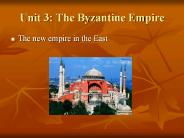Temujin PowerPoint PPT Presentations
All Time
Recommended
Genghis (Chinggis) Khan (Universal Ruler) / Temujin Rise to power illustrates the fluidity of nomadic society Unifies all the tribes, but he needed enemies ...
| PowerPoint PPT presentation | free to download
Mongols before empire- nomadic, headed by khan, tribute system, 1100s- Mongolia dries up, Mongols need new lands. 1206-1265 Genghis Khan (Temujin)
| PowerPoint PPT presentation | free to download
The Mongols CH 12 Beginnings Pastoral nomads in Mongolia Organized in clans and tribes, fighting part of daily life, superior horseback warriors Unified by Temujin in ...
| PowerPoint PPT presentation | free to download
The Mongol Invasion & The Black Death Rise of the Mongols Nomadic Cavalry Temujin Meeting of the Khuraltai Grand Council of Elders Karakorum 1206 Great King ...
| PowerPoint PPT presentation | free to view
... Khan led the Mongols on the first of the series of destructive, ... Was named Temujin after the name of a Tartar chief whom his father, ... the Caesar of Rome. ...
| PowerPoint PPT presentation | free to view
... of Marco Polo (1271-95) and Ibn Batutta (1325-55) Mongol Expansion 1206-1259. Nomads in Turkmenistan. Temujin as Ghengis Kahn c. 1162-1228. Hulagu Kahn 1217-1265 ...
| PowerPoint PPT presentation | free to view
Unit: The Age of Empires Topic: The Rise of the Mongols ... The Mongols
| PowerPoint PPT presentation | free to download
Timelines AP World Review Put the following in order Chapters 1-3 Beginning of Shang Dynasty Rise of Mycenaean Civil. Beginning of Indus Valley Civilization Assyrian ...
| PowerPoint PPT presentation | free to download
Unit: The Age of Empires Topic: The Rise of the Mongols ... The Mongols
| PowerPoint PPT presentation | free to view
The Mongol Conquest Asian Nomads Mongolian Steppe- grassland, good trade route and pastures Pastoralists- herd domesticated animals Always moving with seasons Traded ...
| PowerPoint PPT presentation | free to download
Title: Mongols and Europeans Author: john.cofield Last modified by: Matt Bartula Created Date: 10/6/2006 11:44:01 AM Document presentation format
| PowerPoint PPT presentation | free to view
Unit 3: The Byzantine Empire The new empire in the East Geography Constantinople Location The Bosporus strait Trade Defense Walls Moat Peninsula Geography and natural ...
| PowerPoint PPT presentation | free to view
The Mongols 1200-1500 Overview Traditionally reviled for their brutality Now seen as important for uniting Eurasia for 1st time Mongol empire became noteworthy for ...
| PowerPoint PPT presentation | free to download
The Mongols 1200-1500 Overview Traditionally reviled for their brutality Now seen as important for uniting Eurasia for 1st time Mongol empire became noteworthy for ...
| PowerPoint PPT presentation | free to download
conquering, culture, and change ... Great Sovereign Emperor of All Men Kublai Khan -Grandson Frequent Earthquakes (underwater ones too!)
| PowerPoint PPT presentation | free to view
The Mongols & Global Interactions AIM for Today: To gain a brief overview of the Mongols and how trading became more globalized in the 1200-1300 s.
| PowerPoint PPT presentation | free to view
b. Short, hardy grass grows there. c. Extreme climate with a ... Yurt. The Mongols lived in this environment as nomads (wandering from. place to place in ...
| PowerPoint PPT presentation | free to view
The Mongol and Ming Empires Mongols Nomadic people who lived in the steppes of Central Asia Under Genghis Khan, cast empire stretched from the Pacific ocean to ...
| PowerPoint PPT presentation | free to view
MARCO POLO (1254-1324) TRAVELED IN CHINA (1275-1292) ZHU YUANZHANG (1328-1398) FLOODS (1340s) ... THE WHITE LOTUS SOCIETY. MAITREYA (MILUOFO) 1351-68 (THE RED ...
| PowerPoint PPT presentation | free to view
Mongolian Empire I. Mongols A. Mongols lived in an area North of China B. Nomadic tribe that raised cattle, goats, sheep, and horses C. Followed their herd of animals ...
| PowerPoint PPT presentation | free to download
Despite their domination from a distance, many historians believe their impact was greater on Russia than on China or Persia. Russian princes, who were more or less ...
| PowerPoint PPT presentation | free to view
Chapter 12 Section 2 Key Terms Pastroralists Clan Genghis Khan Pax Mongolica Nomads and the Asia Steppe Two Eurasia steppes Land trade route connector Home to nomadic ...
| PowerPoint PPT presentation | free to view
Title: The History of the UPG Children s Literature Conference Author: upg library Last modified by: Diane M. Hughes Created Date: 9/28/2003 11:22:16 PM
| PowerPoint PPT presentation | free to view
The Mongols Barbarians or Men of the People and Trade Facilitators? Barbara Ozuna and Cheryl Mc Callum Paschal High School, Fort Worth, Texas
| PowerPoint PPT presentation | free to download
The Mongols Overview Eastern steppes of Central Asia Nomads How did being nomadic affect the way you lived and interacted? How did they prepare their children for ...
| PowerPoint PPT presentation | free to view
China Under Mongol Rule The Mongols conquered the Northern kingdoms of China. (Xi and Xia, completely destroyed over two million people) ...
| PowerPoint PPT presentation | free to download
Mongol Eurasia & Its Aftermath 1200-1500 Nomadism in Central Asia Resources Scarce water = Pressure for tribes to move out to find new sources Complex Hierarchy ...
| PowerPoint PPT presentation | free to download
Title: PowerPoint Presentation Author: Niall Christie Last modified by: Stephanie van Willigenburg Created Date: 4/11/2005 12:04:41 AM Document presentation format
| PowerPoint PPT presentation | free to view
Ancient China 3000 BC 1500 AD
| PowerPoint PPT presentation | free to download
Ancient China c.3000 BC 300 AD iRespond Question Master A.) Response A B.) Response B C.) Response C D.) Response D E.) Response E Percent Complete 100% 00:30 ...
| PowerPoint PPT presentation | free to download
Growing wealth of Buddhist Monasteries alarmed the Govt. Persecution of Buddhists, destruction of shrines, monasteries, forced monks and ...
| PowerPoint PPT presentation | free to view
Chapter 10 From the Tang to the Mongols: The Flowering of Traditional China China after the Han (220-581) Division and civil war Nomads from the Gobi Desert Decline ...
| PowerPoint PPT presentation | free to download
Okay, really this is about the Mongols and Africa Mongols Pastoral nomads Steppes of Central Asia Great horsemen Used shortbow Stirrup (allowed you to use your bow on ...
| PowerPoint PPT presentation | free to download
The Mongols - Yola ... The Mongols
| PowerPoint PPT presentation | free to download
Last Name, First Name 12/1 12/5 ? 16 The Mongol Empire I will understand more about the Mongols a people who lived north of China and invaded ...
| PowerPoint PPT presentation | free to download
The Mongol Conquests 12.2 The Mongolian conquests forever changed Asia and Europe. While the Song dynasty prospered, Northern China also prospered.
| PowerPoint PPT presentation | free to view
* * * * * * * * * * * * * * * * * * * * * * * * * * * * * * * * * * * * * * * * * Inventions of the Middle Ages 10 Longships Inventions of the Middle Ages -20 ...
| PowerPoint PPT presentation | free to view
The Mongol Empire Chapter 12 Sections 2 & 3 Mongol Location The Mongols began in Central Asia Steppe dry, hard grasses, cold winters, hot summers.
| PowerPoint PPT presentation | free to view
* The Han Synthesis term refers to the emphasis on Legalism, but with a touch of Confucianism. The Han dynasty recorded Confucius s teachings (The Analects) and put ...
| PowerPoint PPT presentation | free to view
SSWH4b,d: The Russian Empire and the Mongol Empire Chapter 11.2 Pages 307-311 Chapter 12.2 & 12.3 Pages 330-338 The Rise of the Mongols Problems Between Steppe ...
| PowerPoint PPT presentation | free to view
Instructions for using this template. Remember this is Jeopardy, so where I have written Answer this is the prompt the students will see, and where I have ...
| PowerPoint PPT presentation | free to download
ANGKOR WAT: TEMPLE COMPLEX. KORYU DYNASTY: MODELED AFTER CHINA. SUMMARY AND REVIEW ... Built Angkor Wat a city temple: Koryu, Khmer, Songs. Emperor dynasty ...
| PowerPoint PPT presentation | free to view
Mongols The Mongols made no technological breakthroughs, founded no new religions, wrote few books or dramas Why historically significant?
| PowerPoint PPT presentation | free to view
Chapter 14 The Last Great Nomadic Challenges: From Chinggis Khan to Timur I. The Mongol Empire of Chinggis Khan Mongol Culture Nomadic pastoralists Goats, sheep Tribe ...
| PowerPoint PPT presentation | free to view
Arial Calibri Default Design Slide 1 Slide 2 Slide 3 Slide 4 Slide 5 Slide 6 Slide 7 The Mongol Empire at Genghis Khan s Death in 1229 Slide 9 Slide 10 Slide 11 ...
| PowerPoint PPT presentation | free to view
The Muslim World Expands Ch 18 1300-1700 Islam + Muslims Islam is the religion, a Muslim is a follower. Islam means, submission to the will of Allah Allah ...
| PowerPoint PPT presentation | free to download
... (Mongolia and China) Khanate of Chagatai (Central Asia) The Ilkhanate (Persia) Khanate of the Golden Horde (Russia) CHALLENGE QUESTION! IV.
| PowerPoint PPT presentation | free to download
Uniform coinage. Faster travel than ever before... Chinggis Khan and Cavalry. After Chinggis Khan ... Tamerlane's Empire about 1405 C.E. Timur's Revenge. Ring ...
| PowerPoint PPT presentation | free to view
Yuan Dynasty and Mongol Empire * Above is a picture of Suzhou in Jiangsu province showing houses along the Grand Canal. From north to south, the Grand Canal is over ...
| PowerPoint PPT presentation | free to view
The exchange and subsequent transformation of things, ideas, religious and ... 'Kamikaze' or 'divine wind' Inspiration for WWII 'kamikaze' The Mongol Art of War ...
| PowerPoint PPT presentation | free to view
History: The late, great Mongol Empire: origins, spread, and progeny Who were the Mongols? Nomads, pastoralists: Xiongnu (Huns) Turks Mongols Pastoralism, trade ...
| PowerPoint PPT presentation | free to view
A kuriltai or meeting of the Mongol leaders convened in 1206. ... The Mongol army relied on mounted archers. ... Mongol rule was demanding, but also ...
| PowerPoint PPT presentation | free to view
History 210: The late, great Mongol Empire: origins, spread, and progeny Who were the Mongols? Nomads, pastoralists: Xiongnu (Huns) Magyars Mongols Pastoralism, trade ...
| PowerPoint PPT presentation | free to view
Title: Imperial China -- Qin to Ming Dynasties Author: Susan M. Pojer Last modified by: Jeremy ketterling Created Date: 6/23/2000 4:09:29 PM Document presentation format
| PowerPoint PPT presentation | free to download
... Empire was divided into four large Khanates, each ruled by a descendant of Genghis ... Adoption of cultural practices drove the Khanates apart. Mongol Peace ...
| PowerPoint PPT presentation | free to view
























































